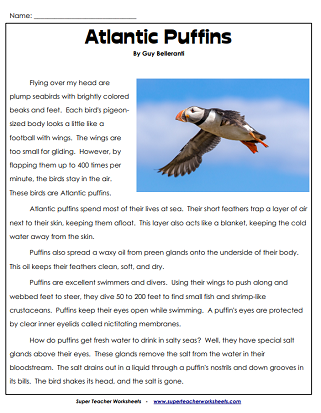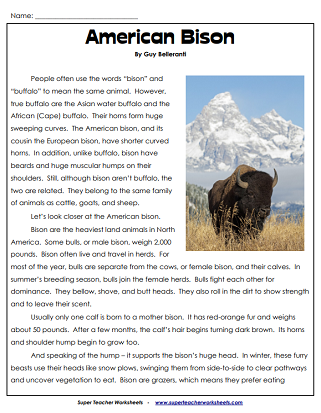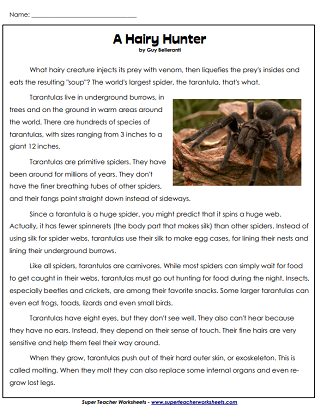What Did The First Animal Look Like
Mammals
Even though information technology is sometimes called globe pigs, aardvarks aren't actually related to pigs at all.
4th Class




Logged in members tin use the Super Instructor Worksheets filing cabinet to save their favorite worksheets.
Rapidly admission your well-nigh used files AND your custom generated worksheets!
Delight login to your business relationship or get a fellow member and bring together our community today to utilize this helpful feature.

Learn all about one of the animals that symbolizes the United states of america of America: the American Bison! Find the differences between bison and buffalo, and notice out what makes the American Bison unique. Comprehension questions are included.
fifth Form
Larn about these white, hirsuite hunters that make their abode in the frozen tundra. You'll be amazed at the ways an arctic fob is adapted to live in its freezing environment.
5th Grade
Larn most the armored mammals called armadillos, which can exist plant in diverse areas throughout Northward and South America.
5th Grade
There are nearly a one thousand unlike species of bat in the world today. Most swallow insects or fruit, but in that location is one type- the vampire bat- that drinks blood.
(Approx. Grade Levels: three-five)
tertiary through 5th Grades
This article contains a list of common beaver questions, such equally "What'south the difference between a beaver lodge and a beaver dam?" Read to find out how much beavers weigh, what they eat, where they alive, and more than.
6th Grade
Bighorn Sheep have horns that counterbalance upwards to 30 pounds. Males will boxing past ramming each other in the head.
4th Form
Did you know that not all brown bears are actually brownish? Learn how you tin can identify a brownish bear in the wild and other interesting facts in this reading action. This worksheet includes comprehension questions, vocabulary words, and a writing prompt.
5th Grade
Larn why camels have humps, how their coat helps them to survive, and other interesting camel facts.
3rd Grade
Learn about our planet's largest species of rodent, the capybara.
4th through 6th Grades
Cheetahs are the fastest land animals in the globe, but fifty-fifty cheetahs take to be on the sentinel for other predators.
5th Grade
Discover what's unusual almost a chipmunk's cheeks, along with other interesting chipmunk facts.
2nd through quaternary Grades
Larn how dolphins and porpoises are alike, and how they're different. This commodity includes a question page, a Venn diagram, and a vocabulary activity.
4th Grade
Find out why these foreign animals are called elephant seals and learn about their unusual hunting habits.
quaternary through 6th Grades
Learn about elephant seals and what makes them unusual in this sixth-grade level reading comprehension article. This activity includes short answer comprehension questions, vocabulary words, and a writing prompt.
sixth Grade
The bushy-tailed, big-eared fennec play tricks in an astonishing species that is adjusted to live in desert climates.
4th Form
Did you know that flying squirrels tin't really fly? They glide from tree to tree, using a furry membrane like a parachute.
fifth through 7th Grades
Did you know behemothic anteaters are one of the few mammals with no teeth? Learn a diversity of interesting facts about behemothic anteaters in this fifth grade scientific discipline article.
fifth Form
Learn about China's beloved and endangered bear. Reading comprehension questions are included.
fifth Form
Learn dozens of fascinating facts most giraffes, then answer the comprehension questions.
3rd Grade
Did y'all know groundhogs are great swimmers? And they can climb trees as well! They can also bawl and whistle. Learn these and many more interesting facts about groundhogs in this article.
2d through 4th Grades
Find everything you wanted to know nigh spiny hedgehogs.
3rd through fifth Grades
The honey badger is arguably the virtually fearless animal on Globe. Information technology eats porcupines and venomous snakes, raids beehives for dear, kidnaps baby cheetahs, and steals nutrient from hungry lions.
4th Grade
Acquire all well-nigh the very loud howler monkey in this reading comprehension article. This worksheet includes comprehension questions, vocabulary identification, and a writing prompt.
5th Form
Hyenas are neither cats nor dogs, but in a family all their own. These vehement scavengers gobble up leftovers left past other animals.
5th Grade
Notice how jaguars live and chase, and learn why these beautiful animals are endangered.
4th through 6th Grades
The cutest mammals in Australia actually have very sharp claws and they spend more time comatose than they do awake.
quaternary Grade
Acquire all nigh the majestic leopard in this reading comprehension article. Worksheet includes comprehension questions, vocabulary words, and a writing prompt.
6th Grade
Did you know that lions are the merely wild cats to live in cooperative groups, called prides? Learn this, and other interesting facts, about lions in this reading comprehension commodity. Includes comprehension questions, vocabulary words, and a writing prompt.
4th Grade
Llamas are are very helpful to man. They piece of work as pack animals that behave heavy goods. They also provide wool for clothing. Some even help ranchers protect their sheep from coyotes.
fourth through sixth Grades
Mandrills, with their vivid blue and red noses, are perhaps the most colorful mammals in the world.
5th Course
Did you e'er wonder what those funny picayune meerkats are doing when they stand up straight and tall? Observe the answer and many other interesting facts about meerkats in this reading comprehension commodity. Worksheet includes a writing prompt, comprehension questions, and vocabulary terms.
5th Course
Learn all about moose, the earth's largest deer, in this fascinating reading comprehension article, complete with comprehension questions, vocabulary words, and a writing prompt. An answer cardinal is included.
5th Grade
Have you ever heard of a barking deer? If y'all visit S America you lot may see muntjacs - small deer that like dogs.
4th Course
Narwhals are sometimes called "Unicorns of the Sea," but do yous know why? It's considering they accept a 9-foot tusk that looks similar a unicorn'due south horn.
6th Grade
The Okapi is a strange animal that looks like a mix betwixt a giraffe and a zebra.
third Grade
Orcas, or killer whales, are known as wolves of the body of water because of their hunting practices.
5th Grade
Did you know that an ostrich's eyes weigh counterbalance twice as much as its brain? Learn interesting facts about ostriches in this nonfiction article. This reading comprehension worksheet is designed for quaternary grade level readers and includes reading comprehension questions, vocabulary exercises, and a writing prompt. Learn about the big and heady ostrich!
4th Class
Learn virtually otters with this high-interest article. Detect differences between river and body of water otters, and find out how we can help protect them. The worksheet features reading comprehension questions, a vocabulary action, and a writing prompt.
4th Grade
Accept you ever heard of the pangolin? This unusual footling animal is the scaliest mammal in the world! Yeah, that'south right! These mammals accept scales! Learn all nigh pangolins in this 5th grade level reading comprehension activeness.
5th Grade
Take you ever heard of the pink fairy armadillo? Learn all almost this miniature armadillo! This article includes short respond and multiple selection questions, vocabulary words, and a writing prompt.
3rd Grade
Learn about the unusual life of world'southward strangest-looking mammal.
4th Form
Find how polar bears accept adapted to live in the Chill.
third through 5th Grades
Learn about the weasel-similar animate being known as the polecat.
4th Course
Information technology rattles similar a rattlesnake and it it gives off a fowl scent like a skunk. What is it? A porcupine!
2nd through 4th Grades
Did you lot know that rabbits and hares are actually different? Learn the similarities and differences betwixt rabbits and hares in this reading comprehension article. Comprehension questions, a writing prompt, and vocabulary words are included.
4th Form
Detect out fascinating facts about these furry mammals in Asia. Students volition discover interesting information about this endangered species.
5th Grade
Learn all nearly reindeer in this intriguing article that explains the difference betwixt the terms "reindeer" and "caribou" and describes what reindeer are like in the wild. Comprehension questions and vocabulary activeness are included.
5th Course
Learn all near incredible rhinos in this reading comprehension article. Short respond comprehension questions, vocabulary words, and a writing prompt are included.
5th Grade
This article volition teach students about the ruby-red kangaroo. Measuring half dozen feet alpine and weighing 200 pounds, information technology is the world's largest marsupial.
6th Class
Learn many fascinating facts about skunks! Did yous know that skunks are actually very shy? Discover this and much more!
2nd Grade
Acquire dozens of fascinating facts virtually stinky, smelly skunks.
2d through 4th Grades
Read most the deadening-moving sloth from Fundamental and South America.
quaternary Course
Bears don't wear glasses, just the spectacled bear from South America has circular markings that make it look like it'due south got spectacles.
quaternary Grade
Echidnas are 1 of just two mammals they lay eggs. Females also have a pouch to carry their babies, simply like kangaroos.
5th Grade
This strange looking animal has 4 legs, a long snout, large ears,and lurks in the forests of Central and Southward America.
4th Form
Learn all about the beautiful and powerful tiger in this reading comprehension article with short answer questions, vocabulary words, and a writing prompt.
4th Grade
The Visayan warty pig is wild sus scrofa that is native to the Visayan Islands of the Philippines. It is one of the world's most endangered animals.
5th Form
The wolverine is a alone, merely fierce, hunter who lives in snowy, northern climates across the world.
fourth Grade
Acquire all virtually imperial wolves in this reading comprehension activeness! Students volition find why wolves howl, where they live, and much more than. This English language language arts activeness includes comprehension questions, vocabulary words, and a writing prompt.
5th and 6th Grades
Acquire about this fascinating marsupial from Down Under! The commodity includes reading comprehension questions, a writing prompt, and vocabulary words.
5th Grade
How do zebras protect themselves from predators? They run, kick, and bite. They even sleep standing up so they're ready to run at any sign of danger.
5th Form
Reptiles
Learn how alligators and crocodiles are dissimilar and how they're similar.
quaternary Grade
This prehistoric reptile looks like a small dinosaur. It has a thick tail, clawed feet, and stiff jaws. Underwater, they keep their mouths open, and utilize their worm-similar natural language to lure in prey.
3rd through 5th Grades
Learn the similarities and differences between boas and pythons with this compare/contrast commodity.
quaternary Class
Chameleons can change colour, rotate their eyes, and have toes that are peculiarly adjusted for climbing.
3rd through 5th Grades
Did y'all know that a king cobra can inject enough venom to impale an elephant? Acquire this, and many more than fun facts about cobras.
5th Class
The desert tortoise lives in the Mojave and Sonoran Desert of the southwestern USA. They get near of their water from food and tin live over 50 years.
5th Grade
Lurking in the deserts of the Southwestern Usa is a colorful monster with a forked natural language, big caput, and powerful claws.
5th Course
The green anaconda is the largest serpent in the world! It lives in South American swamps, weighs 500 pounds and eats pigs, deer, and fifty-fifty jaguars!
fifth Course
Learn tons of fascinating facts about horned lizards in this article.
3rd Course
Larn some fascinating facts about wild and pet iguanas.
3rd through 5th Grades
Are dragons real? You bet they are. Indonesians know all about the tearing cadger known equally the Komodo dragon.
4th Grade
Rattlesnakes are efficient predators, just they can as well be casualty to larger, desert-dwelling animals. They use their rattle to warn predators of their venom.
5th Grade
Did you lot know that body of water turtles have been effectually since the time of the dinosaurs? Learn all about the fascinating world of sea turtles. Discover the names of the seven ocean turtle species, learn about the obstacles baby ocean turtles face when they hatch, and detect out the dangers body of water turtles face up today.
6th Grade
Larn all about body of water snakes in this fascinating article. Did you know in that location are more than sixty species of bounding main snakes? Notice this and other interesting facts almost sea snakes. Worksheet includes reading comprehension questions, vocabulary terms, and a writing prompt.
6th Grade
Take y'all e'er heard of the blue-tongued skink? This unusual Australian animal is surprisingly gentle and can even regrow its own tail! Find out more than about this amazing reptile in this reading comprehension article. Worksheet includes multiple choice questions, vocabulary words, and a writing prompt.
5th Grade
The tuatara is a rare reptile found simply in New Zealand. While it looks similar a cadger, it's actually more closely related to a snake.
fifth Grade
Birds
These beautiful birds brand their home off the coasts of the northeastern U.Southward. and Canada. They live in colonies ranging from hundreds to hundreds of thousands. Learn more than interesting facts about these fascinating sea birds! Activity includes reading comprehension questions, a writing prompt, and vocabulary words.
fifth Course
The earth'south smallest bird - the bee hummingbird - can hover in identify, wing upside downward, and even fly backwards.
4th Grade
The American baldheaded eagle has such good eyesight, it can spot a fish from a mile abroad! It is also a national symbol of the United States.
5th Course
The flamingo is one of the most recognized birds in the world considering of information technology's unusual body shape and hot-pinkish feathers.
4th Form
Learn nigh several birds that run and walk and swim instead of fly.
3rd through fifth Grades
The kiwi is an unusual bird with a long pecker, no tail, and long legs. There are 5 species of kiwis and none of them can fly.
5th Grade
Owls have special adaptations that let them to wing without making a sound, and hunt during the night nighttime hours.
3rd through fifth Grades
Did you know that all peacocks are male? Female peacocks are called peahens. In this article students will learn many fascinating facts most peafowl.
5th Class
Larn nearly 2 dissimilar penguin species - the Emperor penguin and the Galapagos penguin. I of them lives in frigid Antarctica. The other lives on the tropical Equator.
fifth Grade
Did y'all know the peregrine falcon can dive upward to 200 miles per hour and hunt prey at speeds of up to 70 miles per hour? Learn more fascinating facts most the peregrine falcon in this commodity geared toward a 5th grade reading level. Comprehension activities included.
5th Grade
The secretarial assistant bird is a big, terrestrial raptor from Africa. It eats mice, hares, mongooses, lizards, and fifty-fifty snakes.
4th Course
A toucan's colorful nib is certainly beautiful, only did you know that it as well helps the toucan in many ways?
5th Grade
Did you know there are Old Globe vultures and New Earth vultures? Learn the differences betwixt them in this fascinating article. Worksheet includes reading comprehension questions, vocabulary terms, and a writing prompt.
6th Form
What's the difference between a tom, a gobbler, a hen, and a pult? Find out in this article nigh wild turkeys.
2nd Form
Fish
Electric eels certain are electrical, but did you know they're not really eels? Learn interesting facts about electric eels in this reading comprehension article. Includes comprehension questions, vocabulary words, and a writing prompt.
quaternary Grade
It'southward not a bird, nor a plane. It'south a flying fish! Larn all well-nigh these strange animals.
4th Grade
Look out! The world's second largest, and most ferocious shark may exist pond in an ocean well-nigh you.
3rd through 5th Grades
The hammerhead shark is one of the fiercest and almost unsafe animals in the body of water. It uses electroreceptors in its unusual-shaped caput to detect prey.
quaternary Form
Lungfish take the ability to survive in hot, dry climates. They have the ability to go into a dormant stage called estivation, and they have lungs that allow them to exhale air.
5th Grade
A sea creature with two sets of jaws and a long, ophidian-similar body?! That'southward a moray! Learn about the mysterious, shy, and elusive moray eel.
6th Grade
Your students will learn lots of interesting and unusual facts almost seahorses when they read this article.
tertiary through 5th Grades
This article has information about sharks and describes why they are endangered.
fourth Grade
Did yous know that a stingray's skeleton is fabricated upwards of cartilage instead of basic? Learn this and other interesting facts well-nigh stingrays in this quaternary grade level reading comprehension activity.
4th Grade
Amphibians
Detect the similarities and differences between frogs and toads.
3rd through 5th Grades
Can your students tell a reptile from an amphibian? This compare and contrast article will help students larn the differences between these two vertebrate groups.
4th Grade
Learn all about the fascinating poison dart frog. The Colombian poison dart frog is one of the most toxic species on earth, merely did you know toxicant dart frogs may have the ability to help humans?
sixth Grade
Insects, Spiders, and Bugs
Are grasshoppers a farmer's friend or foe? Really, both. Find out how grasshoppers can assistance and harm humans.
3rd through 6th Grades
Learn all about leaf cutter ants, and their highly developed insect society.
6th Grade
Learn how ladybugs got their proper noun, and why some farmers love them.
3rd through 5th Grades
Observe out how to build a mealworm habitat and raise your own darkling beetles.
2nd through 4th Grades
Find out how monarch collywobbles protect themselves and learn nearly their transformation from caterpillar to butterfly.
3rd through 5th Grades
Learn the similarities and differences between butterflies and moths.
4th Grade
Learn all about roly-poly pill bugs, which whorl upward in a ball to protect themselves.
tertiary through 5th Grades
Did you know there are almost 2,000 unlike species of scorpions? Learn this and other fun facts about scorpions in this nonfiction article. Commodity includes comprehension questions, vocabulary words, and a writing prompt.
5th Grade
Pseudoscorpions are tiny, harmless scorpion-like creatures that can sometimes exist found in bathrooms. Read virtually these interesting arachnids and reply the questions. (non-fiction)
third through 5th Grades
Do yous know what the strongest animal on Globe is? A bear? An elephant? Actually it'southward the rhinoceros beetle! This big insect can lift 850 times its own weight!
6th Form
Tarantulas are different from other spiders because they don't spin webs to trap food and they live in surreptitious burrows.
3rd through 5th Grades
Find out about three unlike subgroups of arthropods- insects, arachnids, and myriapods.
4th Grade
Discover the stink issues - an animal that uses a baneful aroma to scare enemies abroad.
3rd through 5th Grades
A a crab and a sea urchin have symbiotic relationship. The sea urchin protects the crab with information technology'due south sharp spikes, while the crab helps the urchin motion around the body of water floor.
6th Grade
Other Animals
Have you ever seen a banana slug? These mollusks really do wait exactly similar the fruit they're named after! Larn interesting facts about assistant slugs in this animal commodity. Includes comprehension questions, vocabulary words, and a writing prompt.
5th Form
Want to larn all well-nigh coral reefs? This article describes the ocean's most unique living community. Home to thousands of species of fish and other bounding main animals, coral reefs play an important role in the well-being of the Earth. This reading comprehension article includes short respond, multiple selection, and vocabulary questions.
third Class
Earthworms have no eyes, no olfactory organ, no ears, no bones, no arms, and no legs. They do, all the same, accept very complex bodies.
second through fifth Grades
I bet you didn't know that an octopus can vanish in a cloud of fume. It'south but one of the unique means an octopus can defend itself.
third through fifth Grades
Learn all most the clever octopus in this nonfiction science article targeted toward a fifth-class reading level!
5th Grade
A fascinating article near a special blazon of jellyfish that tin revert dorsum to infancy and brainstorm its life all once more.
5th Form
Learn about the shy and squishy squid! Did you lot know that a giant squid can abound upwards to the size of a school bus?! Detect other interesting facts in this printable animal article. Vocabulary words, comprehension questions, and a writing prompt are included in this reading comprehension packet.
3rd Grade
Animal Topics
Professor Al Ligator teaches kids near the five groups of vertebrates. Kids volition larn all about mammals, reptiles, birds, amphibians, and fish.
3rd Grade
Many animals utilize camouflage to hide from predators and to avert existence seem while hunting.
tertiary through 5th Grades
Hibernation is when animals slow downward for the wintertime and fall into a slumber-like land. Learn about animal hibernation with this interesting article.
3rd through 5th Grades
Find out why animals drift from 1 place to another.
3rd through 5th Grades
This passage is about animals who are adapted to slumber during the day and become agile during the nighttime hours.
3rd through 5th Grades
Compare and contrast iii types of animals - herbivore, carnivore, and omnivore.
third through fifth Grades
Third Class Reading Comprehension
Third grade stories, articles, passages and poems
Fourth Course Reading Comprehension Worksheets
Fourth grade reading stories, articles, and poems
Fifth Grade Reading Comprehension Worksheets
Fifth grade reading stories, articles, and poems
Science: Animal Worksheets
Animal (vertebrate) classification worksheets
Sample Worksheet Images



Source: https://www.superteacherworksheets.com/animal-articles.html
Posted by: nolandrowend.blogspot.com

0 Response to "What Did The First Animal Look Like"
Post a Comment